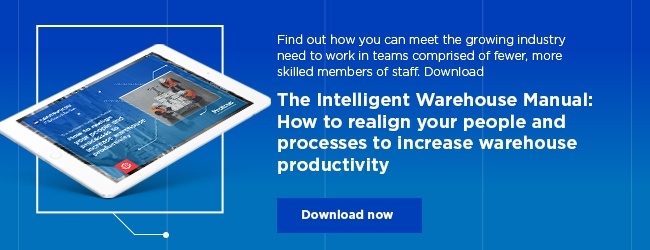See how you can optimise processes and output to manage peaks, and mitigate the need to invest in extra seasonal staff.

Warehouse managers are under more pressure than ever before. Ecommerce has brought about shifts in traditional peak periods, automation is transforming the skills required in the warehouse and Brexit raises uncertainties about the future movement of goods and people.
Labour costs already account for up to 50% of a warehouse’s budget, so any pressures that increase workload, and therefore potentially headcount, must be managed carefully. Plus, 16% of distribution centres are already experiencing skill shortages. How can warehouse managers cope without over reliance on hiring additional resources?
The answer lies in finding as many opportunities as possible to maximise productivity. This is where a warehouse management system (WMS) can help. According to Internet Retailing and eDelivery, retailers that implement a WMS see improvements in productivity and efficiency upwards of 30%. A WMS will help to eliminate inefficiencies at every level of your operations, from warehouse picking processes through to planning and training. Here are seven ways a WMS can help you improve warehouse productivity:

The majority of an operator’s time is spent physically travelling around the warehouse to fulfil orders. A WMS can help you make those journeys as efficient as possible by mapping out the shortest route for each order and each subsequent pick. With a more logical flow to your warehouse picking process, you can minimise the number of operators you need to fulfil orders. What’s more, a WMS can also help you optimise your warehouse layout, by identifying where products and materials should be located and how they should be organised, to make picking and packing as efficient as possible.

Many warehouses still rely on paper-based systems or spreadsheets to allocate tasks to warehouse teams. This takes up a lot of management time without guaranteeing that everyone is fully employed at all times, and makes it hard to gauge true resource requirements. A WMS will dynamically assign specific tasks to warehouse staff in the most efficient and logical sequence, depending on the priority of the activity, so staff are kept busy. Managers have a complete picture of workloads across the warehouse and can reassign tasks and priorities to maximise productivity.

A WMS removes the need for the paper documentation that so often clogs up workflows and gives rise to more human error. By getting rid of all that paperwork flying around, you can reduce the overall amount of time spent on administration and free up teams to take on more value-added tasks.

As well as giving you a holistic view of warehouse activity, a WMS allows you to accurately track individual performance. You can then use its data to set productivity targets, spot areas of training need, and incentivise better performance with bonuses, so staff can achieve more.

Training is necessary to develop the flexible skills needed for the future. Cross-training gives you extra capacity when you need it by giving current staff the opportunity to acquire new skills. A WMS allows you to make the most of your existing workforce minimising the requirement to hire specialist or temporary resources.

Predicting how many workers you need and when you need them is tricky, even with years of experience. A WMS helps to take away some of the unknowns, supporting your decision-making by providing predictive capabilities based on comprehensive historical data. More accurate predictions of your labour requirements will allow you to avoid understaffing or overstaffing the warehouse during peak periods and minimise costs.

Capturing critical KPIs gives you baseline metrics that will help you identify where to make improvements and track performance over time. If you measure everything you do regularly, you can create a programme of continuous improvement with achievable business goals, timescales and objectives for key individuals in order to boost employee productivity over time. The right WMS will provide a comprehensive set of performance measures that enable you to review and analyse productivity improvements, then adapt your methods accordingly to achieve consistent progress. Ultimately, this will help you control and reduce labour costs.
Increasing customer demand, looming pressures posed by Brexit and the rise of automation mean that the warehouse needs to improve processes, retain staff and develop new skills. If warehouse managers adopt these best practices with the support of a WMS, they can keep productivity up, headcount down and put themselves in the best position to meet the demands of peaks to come.
.png?width=219&name=logo%20(1).png)










